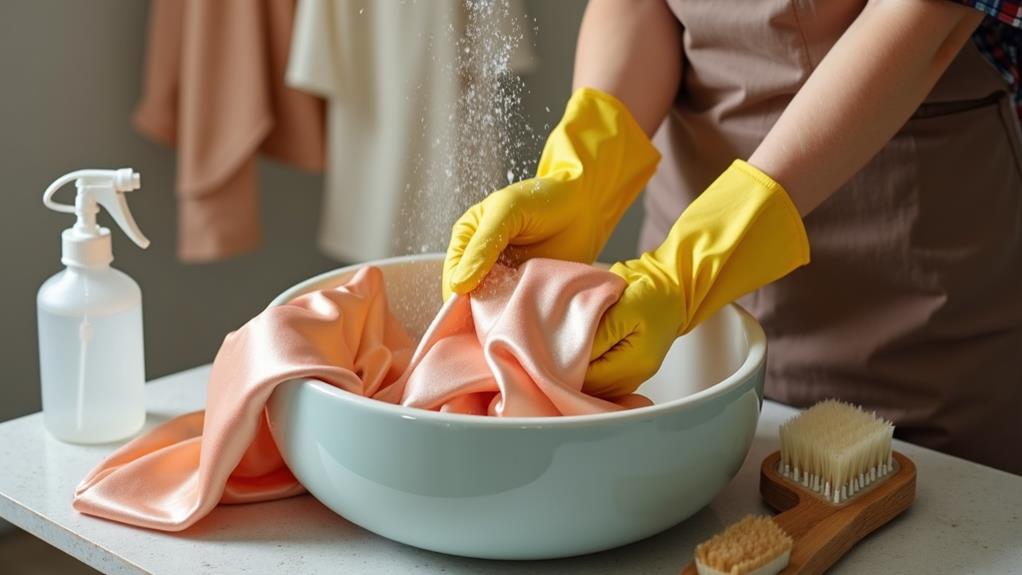To clean Thai silk, follow these five steps: First, inspect for stains and pre-treat if necessary. Next, prepare a lukewarm washing solution using a delicate detergent or pH-balanced shampoo. Gently soak and clean the silk by hand, massaging the fabric to loosen dirt. Rinse thoroughly with cool water, carefully squeezing out excess moisture without wringing. Finally, dry the silk flat or hang it in a shaded, well-ventilated area, and use a handheld steamer to remove wrinkles. By following these steps, you'll maintain your Thai silk's lustrous appearance and delicate fibers. Discover more detailed techniques to guarantee your silk garments remain in pristine condition.
Table of Contents
Key Takeaways
- Inspect for stains and pre-treat with a gentle stain remover suitable for delicate fabrics.
- Prepare a lukewarm water solution with mild detergent or pH-balanced shampoo for silk.
- Submerge and gently hand wash the silk, allowing it to soak briefly to loosen dirt.
- Rinse thoroughly with cool water and remove excess moisture by gently squeezing, not wringing.
- Dry flat or hang in a shaded, well-ventilated area, and use a handheld steamer to remove wrinkles.
Check for Stains
Before you begin cleaning your Thai silk garment, it's essential to carefully inspect it for any visible stains. Examine the fabric thoroughly, paying close attention to areas prone to staining, such as collars, cuffs, and hemlines. Once you've identified any stains, you'll need to address them before proceeding with the cleaning process.
Use a gentle stain remover specifically designed for delicate fabrics to treat the affected areas. Apply the product directly to the stain, following the manufacturer's instructions carefully. Pre-treating stains is pivotal for effective removal and prevents them from setting into the fabric during washing. This step is fundamental for quality maintenance of your Thai silk garment.
Proper stain removal techniques are crucial in preserving the pristine condition of Thai silk. Be sure to test the stain remover on an inconspicuous area first to ensure it doesn't damage or discolor the fabric.
Gently work the product into the stain using a soft, clean cloth or sponge. Allow the stain remover to sit for the recommended time before proceeding with the cleaning process. By addressing stains prior to washing, you'll help maintain the overall appearance and longevity of your Thai silk garment.
Prepare Washing Solution
Your Thai silk's cleaning journey begins with preparing an appropriate washing solution. Fill a sink with lukewarm water, making sure the temperature isn't too hot or cold for the delicate silk fabric. Add a specially formulated delicate detergent suitable for silk, following the dosing instructions provided on the bottle. If you don't have a specific silk detergent, a pH-balanced shampoo can serve as an alternative.
| Solution Component | Purpose |
|---|---|
| Lukewarm water | Gentle cleansing medium |
| Delicate detergent | Effective, safe cleaning |
| pH-balanced shampoo | Alternative cleaning agent |
| Sudsy mixture | Dirt and stain removal |
Once you've added the cleaning agent, mix it thoroughly to create a sudsy solution. Make sure the silk garment is completely submerged in this mixture. The soaking process is essential for effective cleaning, as it allows the solution to penetrate the fabric and loosen any dirt or stains. This step sets the foundation for a thorough cleaning process, preparing your Thai silk for the subsequent washing and rinsing stages. Remember, the key to preserving your silk's quality lies in using gentle, suitable cleaning solutions and techniques throughout the process.
Soak and Gently Clean
With the washing solution prepared, it's time to initiate the soaking and cleaning process for your Thai silk garment. Carefully submerge the silk in the lukewarm, soapy water you've prepared. Make sure the fabric is fully immersed to allow for even cleaning.
Gently massage or stir the silk in the water, using a hand wash technique. This action helps the detergent penetrate the fabric fibers, effectively removing dirt and stains. Be cautious not to wring or twist the delicate silk, as this can damage its structure.
Allow the garment to soak for a few minutes. This soaking period is essential for loosening any stubborn dirt or stains. If you encounter particularly resistant stains, you may apply a gentle stain remover specifically formulated for silk fabrics.
After the soaking period, thoroughly rinse the silk with cool water. This step is important to remove all traces of detergent, which could otherwise compromise the fabric's integrity. Continue rinsing until the water runs clear, making sure no soap residue remains.
Throughout this process, handle the silk with care to maintain its delicate fibers and lustrous appearance.
Rinse and Remove Excess Water
After thoroughly cleaning your Thai silk garment, it's important to rinse out all traces of detergent. Use clear, cool water to guarantee complete removal of soap residue, which can affect the fabric's texture and appearance. Gently submerge the silk garment in the water, moving it carefully to allow thorough rinsing.
Once rinsed, you'll need to remove excess water without harming the delicate fibers. Remember, wet silk is weaker than dry silk, so handle it with caution. Gently squeeze the garment, avoiding wringing or twisting motions that could damage the fabric. This careful squeezing helps maintain the integrity of the silk fibers during the cleaning process.
To create vivid imagery, consider these steps:
- Imagine cool water cascading over the silk, carrying away soap residue
- Picture your hands gently cradling the wet silk, supporting its weight
- Envision water droplets slowly falling from the fabric as you gently press
- Visualize the silk's shimmering surface as excess moisture is removed
- See yourself carefully laying the damp garment flat in a shaded area
After squeezing, you can either roll the silk in a clean white towel to absorb more moisture or lay it flat to dry. Avoid direct sunlight, which can harm the fabric. By following these steps, you'll effectively clean your Thai silk while maintaining its quality.
Dry and Steam Silk

Drying and steaming Thai silk requires precision and care to maintain its luxurious texture and appearance. After washing, take a clean white towel and gently roll the wet silk, squeezing out excess moisture. This method is far gentler than using washing machines, which can harm the delicate fibers.
When drying Thai silk, avoid direct sunlight as it can weaken the fabric and cause discoloration. Instead, hang the silk in a well-ventilated area away from heat sources. Once dry, you'll need to eliminate wrinkles and restore the silk's smooth surface.
Steaming is an effective method for this purpose. Use a handheld steamer, holding it about 6 inches away from the fabric. Move the steamer in gentle downward strokes, taking care not to apply too much pressure or heat in one area. This technique helps preserve the silk's structure, which is one of the strongest natural fibers.
After steaming, hang the Thai silk on a padded hanger to dry completely. Avoid using an ironing board, as direct heat can harm the fabric. By following these steps, you'll guarantee your Thai silk maintains its luxurious quality and appearance for years to come.











